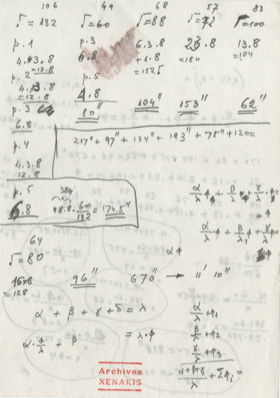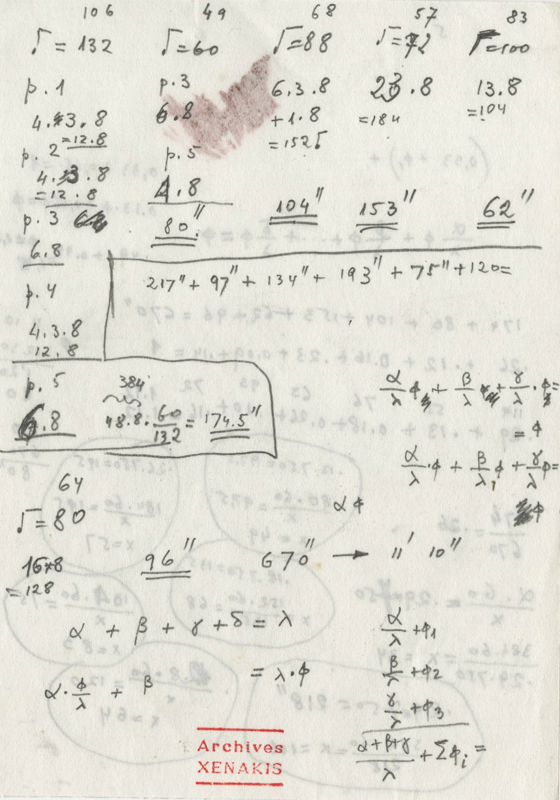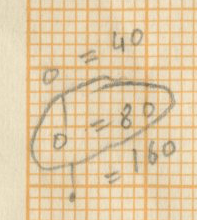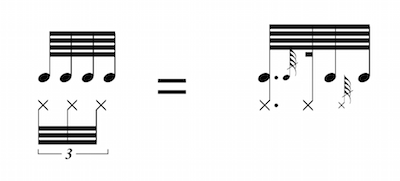Improving the practice and performance of contemporary music
General Considerations
Okho and Rebonds are published by EDITIONS SALABERT/UNIVERSAL MUSIC PUBLISHING CLASSICAL FRANCE
Formal Analysis based on narrative structures
Certain musicologists and researchers that have been analyzing works by Xenakis approach the formal aspect of his compositions as being constructed by simple juxtapositions (1). It is true that the majority of the works (2) at first sight have a “collage” style of writing but we believe we have to agree with Anne-Sylvie Barthel-Calvet who states in her thesis “Le Rythme dans l’oeuvre et la pensée de Iannis Xenakis” (3) that Xenakis’ works have to be analyzed by the use of “narrative structures” as described in the work of M. Grabocz (4).
The feeling a listener experiences while listening to Xenakis’ music is certainly not eclecticism or incoherence. On the contrary, this music possesses and distributes a sort of tribal coherence that leads us to the thinking of Barthel (5) and Grabocz.
Material borrowed from former pieces
Tempi Alterations
Choice of instruments
For Okho we suggest to use traditional African rope-tuned djembes. Of course the more modern drums of companies like Remo, Latin Percussion or Meinl are easier for daily use and tuning, and often the skins last longer due to equalized tuning; but the sound of the traditional djembes fits much more the sound idiom that one associates with the force of Xenakis’ music. For performance and presence reasons we also suggest to play the piece standing, using djembe stands or even traditional body straps to mount the djembes.
Xenakis states in the score to use a large African drum (“Une peau Africaine de grande taille”) for the bass note interjections in the middle of the piece and for the very last note of the piece. We suggest using a concert bass drum with natural skin heads. The model we used for the recording was a 28-inch Dicke Bertha by Kolberg Percussion with goat and calf heads on the respective sides (6).
Many people try to make one general setup for Rebonds A and B. We however find that due to the difference in composition strategy for both pieces it is more appropriate to use separate setups for both pieces. For Rebonds A it is logistically difficult to incorporate two large concert bass drums into the setup. Therefore we take one concert bass drum for the lowest instrument and take a large tom of 16 or 18 inches as the second bass drum. To maintain the division of the instruments Xenakis states in the score (2 bass drums, 3 toms and two bongos), we make sure the skins and the tuning of the two instruments that serve as bass drums are of the same type and idem dito for the toms and the bongos. It is strongly advised to use natural skin heads on all instruments. We use goatskins from Altenburger Pergament und Trommelfell (7) that are pre-mounted on aluminium rims for easy use on all the toms. The bass drum we used is the same as the one used for Okho. We asked Pierre-Francois Resta to design hard rubber mallets with a thicker rattan shaft to add sufficient weight to the mallet. Rubber mallets are advised for Rebonds A to take out the harsh attack of wooden mallets and to make the playing sound almost like a tabla player.
The same differentiation in skins and tuning applies to the setup of Rebonds B. As a bass drum we used a 16-inch tom to reduce the size of the setup, but tuned the skin very low to make it sound like a bass drum. Both plastic heads like a Remo Power stroke 4 (8) or heads from the Aquarian Drumheads Vintage Series (9) or calf or goatskin heads can be used. The calf head option works well in addition to a goatskin head on the tom.
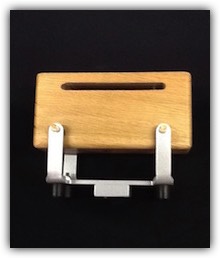

Approach to practicing polyrhythms
Notes
- BARTHEL-CALVET, Anne-Sylvie, Le rythme dans l'oeuvre et la pensée de Iannis Xenakis, thèse de doctorat. Paris, Ecole des Hautes Etudes en Sciences Sociales, 2000, 2 vol., 700 + 482 p.: p. 497
- As stated by Makis Solomos and referred to by Barthel-Calvet: BARTHEL-CALVET, Anne-Sylvie, Le rythme dans l'oeuvre et la pensée de Iannis Xenakis, thèse de doctorat. Paris, Ecole des Hautes Etudes en Sciences Sociales, 2000, 2 vol., 700 + 482 p.: p. 555
- EN: “Rhythm in the works and the mind of Iannis Xenakis”
- GRABOCZ M., “Les trois modes de la narrativité en musique” in BARTHEL-CALVET, Anne-Sylvie, Le rythme dans l'oeuvre et la pensée de Iannis Xenakis, thèse de doctorat. Paris, Ecole des Hautes Etudes en Sciences Sociales, 2000, 2 vol., 700 + 482 p. pp. 554-557
- BARTHEL-CALVET, Anne-Sylvie, « La fin d’œuvre chez Xenakis : enjeux narratifs », La fin d’œuvre en musique : sens et significations, entre création et réception, Grégoir Caux & Mathias Roger (éds.), Sampzon, Delatour, 2013, p. 73-82
- Kolberg Percussion gmbh, Grosse Trommel “Dicke Bertha”, 2015 (http://www.kolberg.com/products/de_DE/943/product/1199.html)
- Altenburger Pergament und Trommelfell gmbh, 2015 (http://www.pergament-trommelfell.de/)
- Remo Inc “Powerstroke 4”, 2015 (http://remo.com/portal/products/3/8/49/157/cl_powerstroke4.html?type=Snare%2FTom+-+Batter+and+Resonant)
- Aquarian Drumheads Inc “Vintage Series”, 2015 (http://www.aquariandrumheads.com/products/vintage-heads/vintage-series/)
